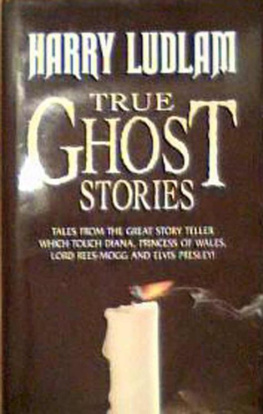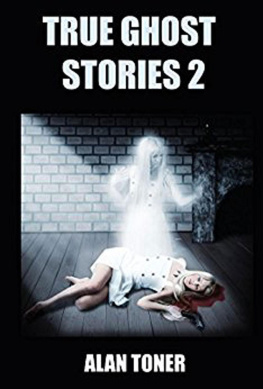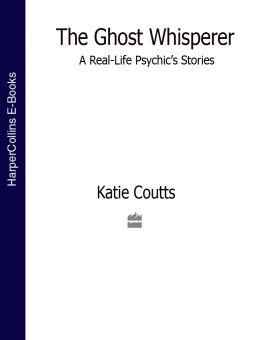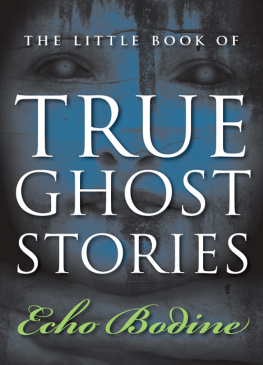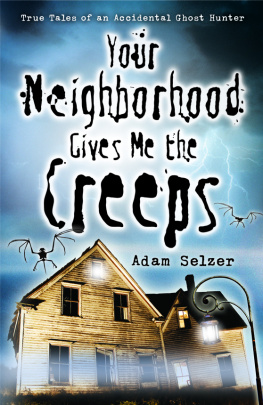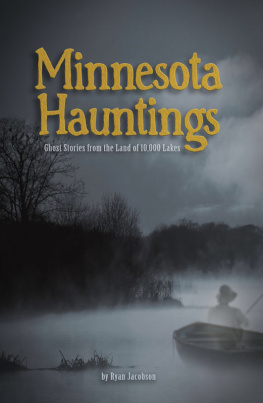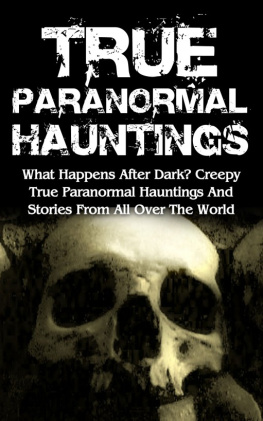
foulsham
The Oriel, Thames Valley Court, 183-187 Bath Road, Slough, Berkshire SL1 4AA, England
ISBN: 978-0-572-00000-0
Copyright 2009 W. Foulsham & Co. Ltd
A CIP record for this ebook is available from the British Library
All rights reserved
The Copyright Act prohibits (subject to certain very limited exceptions) the making of copies of any copyright work or of a substantial part of such a work, including the making of copies by photocopying or any digital process. Written permission to make a copy or copies must therefore normally be obtained from the publisher in advance. It is advisable also to consult the publisher if in any doubt as to the legality of any copying which is to be undertaken.
Table of Contents
Introduction
T he fascination of ghosts, the real life kind, lies in the remarkable variety of forms that hauntings can take, and their stunning impact on those people fortunate - or unfortunate - enough to encounter them.
Real ghosts obey no natural laws. They are ageless, timeless. They emerge both in the dark and the daylight, and they appear mostly to ordinary people going about their everyday lives, people who have rarely given a second's thought to talk of ghosts.
But ghosts there are. A bewildering multiplicity of them.
Some hauntings I investigated have featured a single ghost, others several. Some had a handful of witnesses, others dozens. Some terrorised whole families, driving them out of their homes.
There are ghosts that appear fleetingly, others that linger for weeks or months, and some that persist for years. In my experience, a good number of these wandering earth-bound spirits are soon identified, but others remain a mystery until long afterwards.
There is absolutely nothing at all to compare with the spine-tingling sensation of seeing a ghost, or in making the chilling discovery that 'something' has invaded one's home. The shock. The wonderment. And, all too often, the distress. For some of the more troublesome ghosts can be noisy, cantankerous or of a decidedly evil nature.
My collection of true cases, drawn from all quarters of the ghost world, show how its restless spirits impinge on our lives. Every day. Everywhere. And how police, clergy and psychic investigators are called to the aid of those victims of hauntings reduced to desperate states.
My thanks to everyone for helping me to tell of these uncanny experiences just as they happened.
Harry Ludlam

The Beautiful Duchess
S he was beautiful and sexy. She was without conscience, shame or fear. She was ambitious, extravagant, greedy, arrogant, vain, and possessed of a scandalous tongue. She was Elizabeth, Countess of Dysart, afterwards Duchess of Lauderdale, and she haunts Ham House, a mansion on the banks of the River Thames in Richmond, Surrey.
Elizabeth was the eldest daughter of the Earl of Dysart. Her parents having no son, a Royal charter was obtained to enable her to succeed to the title. In 1647 she married a baronet, Sir Lionel Tollemarche, and four years later they acquired Ham House, which had been built some forty years earlier.
Elizabeth was, as they say, the kind of girl who had been around, and they had not been married long before she became steeped in affairs, courtiers and dashing gallants flocking around her wherever she went. In earlier years she had had an affair with Oliver Cromwell, and now, with him gone and Charles II on the throne, her carryings-on with John Maitland, Duke of Lauderdale, were too much even for the court of the Merry Monarch. Through all this her husband, Sir Lionel, kept a low profile; bowing, it seems, to power and money.
The Countess's friendship with the Duke of Lauderdale dated back to pre-marriage days. She always maintained that she had only saved Lauderdale, a Royalist, from the scaffold by submitting to the desires of the Protector. But now, in the midst of their hot-blooded affair, she and Lauderdale quarrelled, for whatever reason, and a certain coolness arose between them. No matter, she was still intent on getting her man. When her husband, Sir Lionel, conveniently died, she at once made new advances to the Duke, with the result that his wife left him and went to live in Paris. She died three years later and the way was clear for the Countess to become a Duchess. She finally landed Lauderdale in his fifties and they were married in 1671.
From the start of this new marriage it was the Duchess who ruled at Ham House, as she had done before. The Duke might be one of the King's more powerful ministers and a member of the secret council, the Cabal, but it was Elizabeth who wielded power at home. She saw to it that they lived in the grand manner, trying to outdo royalty in the splendour of their wild parties and other entertainments. Her jewellery and costumes were said to eclipse in cost and magnificence those of any other lady of the court. She filled the mansion with beautiful things: furniture, tapestries, draperies, pictures. She was a great survivor, remaining blithely untouched by the intrigues and dark deeds that went on around her in those days, and she also outlived her husband by many years. Lauderdale died in his sixties, in 1682; she lived on till 1698. She was succeeded in her estates and title of Dysart by her eldest son by her first husband, Lionel Tollemarche, the house remaining occupied by that family for the next two-and-a-half centuries.
And by the infamous old Duchess of Lauderdale herself, too. In the still hours of the night the tapping of heels and of a stick were sometimes heard crossing the polished oak boards of various of the rooms and ascending and descending the great staircase. Sometimes they stopped outside one room and sometimes another, and occasionally, not content with hovering outside, the Duchess's ghost would enter a room.
Late in the nineteenth century the haunting took a surprise turn. The little daughter of a butler at Ham House was on a visit to her father, by permission of the Tollemarche family, when she was awakened in the early hours of the morning by a curious noise in the room. Thinking it was either a mouse or a bird, she sat up and, looking in the direction of the sounds, saw a little old woman kneeling by the fireplace, scratching on the panelling of the wall with long, claw-like fingernails. Turning round and seeing the child gazing at her, the old woman got up and, leaning on the rail of the child's bed, stared fixedly at her. Her eyes glittered and her expression was so menacing that the child screamed and hid under the bedclothes. Fortunately some of the household were near at hand and came running to the room, but the ghost had vanished.
On recovering from her fright the child described what she had seen. The Tollemarches, who were told about it the next day, had the panelling removed. Behind it, it is recorded, were found old documents whose contents left little doubt that Elizabeth, Countess of Dysart, had murdered her first husband, Sir Lionel Tollemarche, in order to marry her long-standing love, the Duke of Lauderdale. The ghost the little girl had seen was in all probability that of the murderess.
It might be thought that the haunting would now stop, but it did not. The Duchess's phantom footsteps continued their occasional nightly progression, even when Ham House passed to the National Trust in 1948. They went on and on. In 1995, when a new property manager for the Trust moved into Ham House with her husband and three children, they had only been in the house two weeks when she was obliged to call in a priest to bless the top flat where they resided. This, apparently, improved the unpleasant atmosphere there, but it did not put an end to the Ham House haunting doors slamming, footsteps walking up and down stairs, patches of cold air invading certain parts of the old Stuart mansion. Just when it is thought the ghost has gone, back it comes again.
Next page
